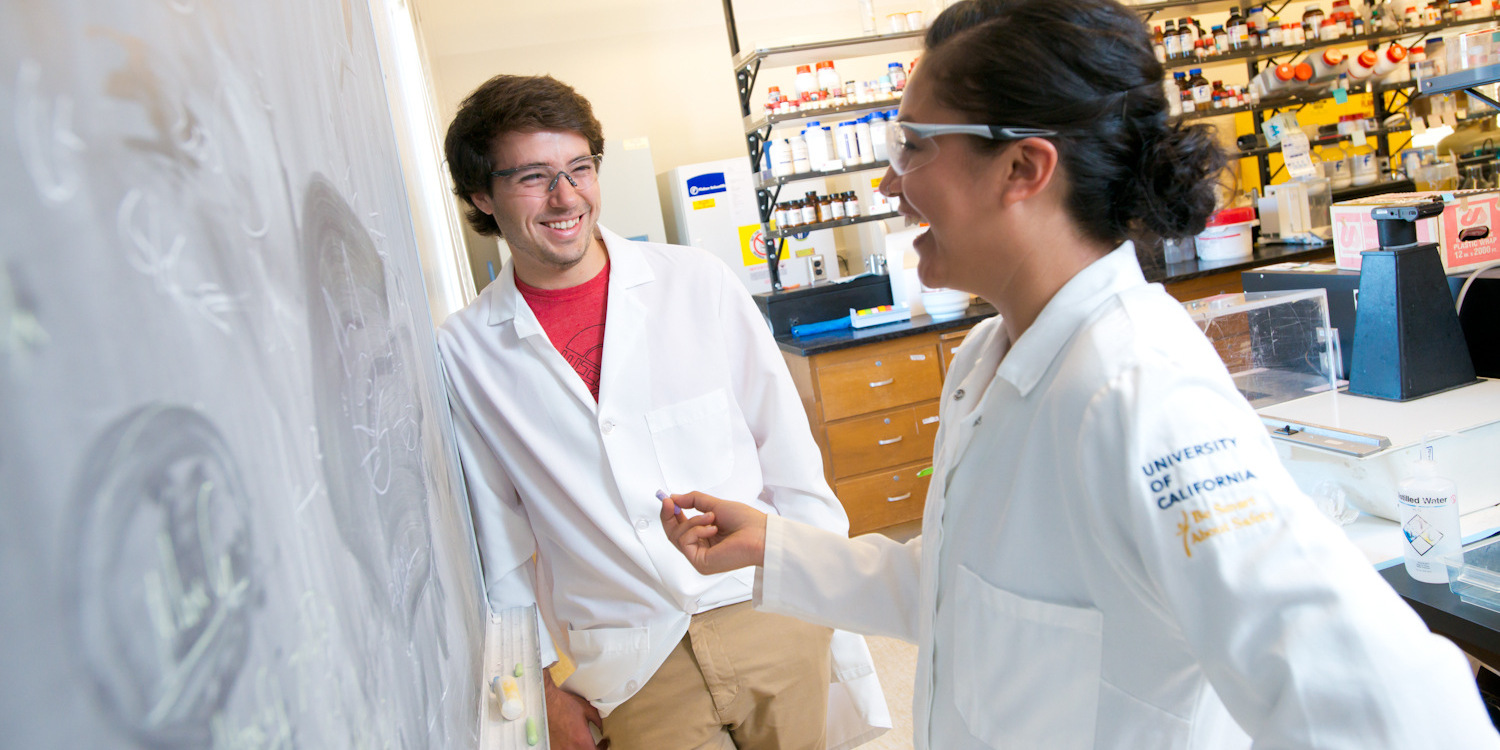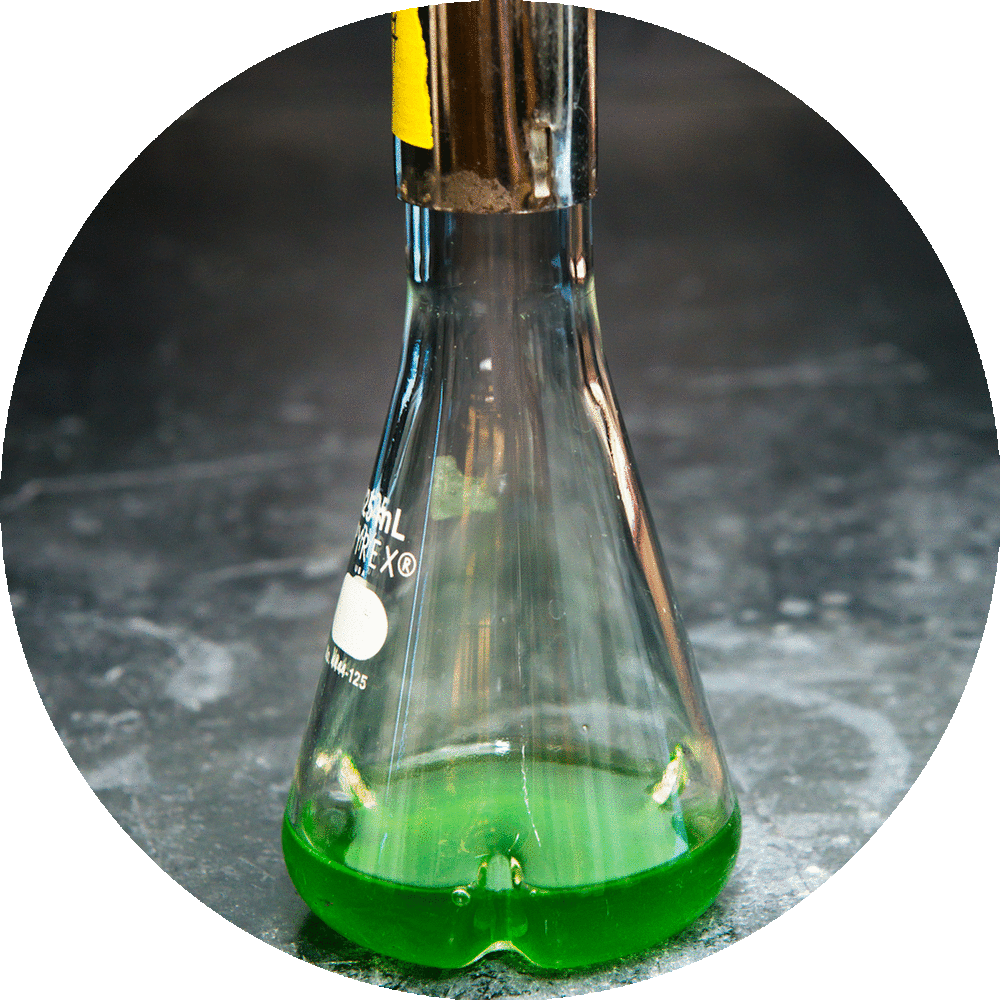
The Chemical Biology Program (CBP) is supported by a NIH T32 Training Grant (July 1, 2021 - June 30, 2026), with matching funds from UC Davis, providing fellowships for 6-7 highly qualified predoctoral candidates annually. Our goal is to engage students in effective cross training at the interface of chemistry and biology. Through the CBP, trainees will develop an understanding for the value of the synthesis and analysis tools traditionally associated with chemistry in addressing biological questions relating to human health.
A trainee from this program will be equipped to move comfortably into a scientific career that requires them to communicate with both chemists and biologists (e.g. leading teams of investigators comprising both chemists and biologists or executing research projects with significant chemical and biological components). This will be achieved by a combination of coursework, laboratory rotations, individual development plans (IDP), research-in-progress presentations, career development activities and annual retreats.
Training Activities
- Pre-funding Phase: Year 1
- Graduate group-specific "first year" curriculum (courses, rotations, teaching, seminars, safety training, etc.)
Student joins research group associated with the CBP
Student applies to the CBP - Funded Phase: Years 2-3
Updated June 2023: CBP fellows are required to take 2 courses: CHE 238: Introduction to Chemical Biology and Chemistry 298 - Rigor & Reproducibility in Chemical Biology Research. These courses should be completed in the soonest available quarter of the second year of graduate study (the first year of CBP support), if not before. Any additional cross-training course is now optional.
Thesis research
Safety training
Research in progress meetings (i.e. CBIG)
Career development activities (i.e. GradPathways, etc.)
Annual CBP Retreat
Complete the Responsible Conduct of Research program certificate series
Annual review of Individual Development Plan (IDP)
Research seminars- Post-funding Phase: Years 4+
- Thesis research
Safety training
Research in progress meetings (i.e. CBIG)
Career development activities (i.e. GradPathways, etc.)
Annual CBP Retreat
Annual review of IDP
Research seminars
Financial Support
The NIH T32 Training Grant and University Matching Funds provides funding for up to two years of your graduate education (years two and three), including a stipend and all tuition and fees. This funding is contingent upon satisfactory progress in your graduate Ph.D. training. This includes, but is not limited to, maintaining a minimum 3.0 GPA in all required coursework, making satisfactory progress in all research-related activities and participating in Program activities.
Participating Graduate Groups
If you are a prospective UC Davis graduate student, before applying for the CBP fellowship, you must first apply and be accepted to one of our participating graduate groups. Specific application requirements and deadlines vary and may be found on their respective websites and from the Office of Graduate Studies.
- Biochemistry, Molecular, Cellular and Developmental Biology
- Biomedical Engineering
- Biophysics
- Chemistry
- Pharmacology and Toxicology
- Integrative Genetics and Genomics
Participating Faculty
The faculty listings below are sorted by graduate group affiliations. Graduate groups embody the collaborative spirit of discovery at UC Davis by bringing together scholars from different areas of study who share common research interests, which means many of our faculty belong to more than one graduate program. You may also refer to our faculty directory for an alphabetical listing.
- Biochemistry, Molecular, Cellular and Developmental Biology
- Shota Atsumi | Synthetic biology and metabolic engineering
Peter Beal | Nucleic acids chemical biology
Sheila David | Chemical biology of DNA repair
Oliver Fiehn | Mass spectrometry and computation chemistry for metabolomics
Andrew Fisher | Protein structure-function and X-ray crystallography
Christopher Fraser | Cellular and viral mRNA translation in humans
Bruce Hammock | Biological chemistry of regulatory lipids, medicinal chemistry
David Segal | Genome engineering tools and therapeutics - Biomedical Engineering
- Randy Carney | Nanoplasmonics, Raman spectroscopy/SERS, exosomes, cancer diagnostics
Kit Lam | Lymphoma, targeted therapy for cancer, molecular imaging, drug development and combinatorial chemistry
Angelique Louie | Molecular imaging and novel imaging probes
Matthew Paszek | Investigating how signaling patterns emerge from spatial arrangements outside of thermodynamic equilibrium and what role mechanical forces and biophysical interactions play in organizing biomolecules at molecular length scales
Cheemeng Tan | Synthetic biology, artificial cellular systems, gene regulation, cellular heterogeneity, antibiotic treatment
Aijun Wang | Stem cells, biomaterials, tissue regeneration, vascular disease, birth defects
- Biophysics
- James Ames | Biophysical chemistry and structural biology
James Letts | Membrane protein electron transport complexes in bioenergetics and immunity
Justin Siegel | Computational enzyme design
Cheemeng Tan | Synthetic biology, artificial cellular systems, gene regulation, cellular heterogeneity, antibiotic treatment
Igor Vorobyov | Molecular modeling and simulations of molecular systems - Chemistry
- James Ames | Biophysical chemistry and structural biology
Shota Atsumi | Synthetic biology and metabolic engineering
Peter Beal | Nucleic acids chemical biology
Xi Chen | Chemical biology/glycoscience
Sheila David | Chemical biology of DNA repair
Oliver Fiehn | Mass spectrometry and computation chemistry for metabolomics
Andrew Fisher | Protein structure-function and X-ray crystallography
Alec H. Follmer | Advancing the frontiers of metalloenzymology by designing innovative approaches to understand the non-equilibrium dynamics that drive the catalytic processes of metal-containing enzymes
Annaliese Franz | Organic synthesis, catalysis, and biofuels
Marie Heffern | Bioinorganic chemistry in nutrition and diseases, chemical biology and imaging
Kit Lam | Lymphoma, targeted therapy for cancer, molecular imaging, drug development and combinatorial chemistry
Carlito Lebrilla | Bioanalytical mass spectrometry
Angelique Louie | Molecular imaging and novel imaging probes
Elizabeth Neumann | Understanding the molecular and cellular architecture behind neurological diseases
David Olson | Organic synthesis and chemical neuroscience
Jared Shaw | Synthetic methods, natural products, chemical biology
Justin Siegel | Computational enzyme design
Dean Tantillo | Theoretical organic chemistry, natural products biosynthesis - Pharmacology and Toxicology
- Sheila David | Chemical biology of DNA repair
Oliver Fiehn | Mass spectrometry and computation chemistry for metabolomics
Bruce Hammock | Biological chemistry of regulatory lipids, medicinal chemistry
Kit Lam | Lymphoma, targeted therapy for cancer, molecular imaging, drug development and combinatorial chemistry
David Segal | Genome engineering tools and therapeutics
Aijun Wang | Stem cells, biomaterials, tissue regeneration, vascular disease, birth defects
Heike Wulff | Design of potassium channel modulators - Integrative Genetics and Genomics
- Randy Carney | Nanoplasmonics, Raman spectroscopy/SERS, exosomes, cancer diagnostics
David Segal | Genome engineering tools and therapeutics
Nitzan Shabek | Molecular mechanisms of signaling pathways and their regulation by proteolytic systems
Cheemeng Tan | Synthetic biology, artificial cellular systems, gene regulation, cellular heterogeneity, antibiotic treatment
